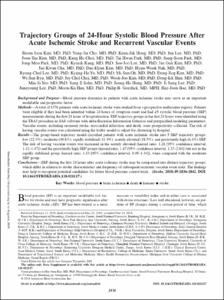Trajectory Groups of 24-Hour Systolic Blood Pressure After Acute Ischemic Stroke and Recurrent Vascular Events
- Keimyung Author(s)
- Sohn, Sung Il; Hong, Jeong Ho
- Department
- Dept. of Neurology (신경과학)
- Journal Title
- Stroke
- Issued Date
- 2018
- Volume
- 49
- Issue
- 8
- Keyword
- blood pressure; brain ischemia; death; humans; stroke
- Abstract
- Background and Purpose
Blood pressure dynamics in patients with acute ischemic stroke may serve as an important modifiable and prognostic factor.
Methods
A total of 8376 patients with acute ischemic stroke were studied from a prospective multicenter registry. Patients were eligible if they had been admitted within 24 hours of symptom onset and had ≥5 systolic blood pressure (SBP) measurements during the first 24 hours of hospitalization. SBP trajectory groups in the first 24 hours were identified using the TRAJ procedure in SAS software with delta-Bayesian Information Criterion and prespecified modeling parameters. Vascular events, including recurrent stroke, myocardial infarction, and death, were prospectively collected. The risk of having vascular events was calculated using the frailty model to adjust for clustering by hospital.
Results
The group-based trajectory model classified patients with acute ischemic stroke into 5 SBP trajectory groups: low (22.3%), moderate (40.8%), rapidly stabilized (11.9%), acutely elevated (18.5%), and persistently high (6.4%) SBP. The risk of having vascular events was increased in the acutely elevated (hazard ratio, 1.28 [95% confidence interval, 1.12–1.47]) and the persistently high SBP groups (hazard ratio, 1.67 [95% confidence interval, 1.37–2.04]) but not in the rapidly stabilized group (hazard ratio, 1.13 [95% confidence interval, 0.95–1.34]), when compared with the moderate SBP group.
Conclusions
SBP during the first 24 hours after acute ischemic stroke may be categorized into distinct trajectory groups, which differ in relation to stroke characteristics and frequency of subsequent recurrent vascular event risks. The findings may help to recognize potential candidates for future blood pressure control trials. (Stroke. 2018;49:1836-1842. DOI:10.1161/STROKEAHA.118.021117.)
- Publisher
- School of Medicine (의과대학)
- Citation
- Beom Joon Kim et al. (2018). Trajectory Groups of 24-Hour Systolic Blood Pressure After Acute Ischemic Stroke and Recurrent Vascular Events. Stroke, 49(8), 1836–1842. doi: 10.1161/STROKEAHA.118.021117
- Type
- Article
- ISSN
- 1524-4628
- Source
- https://www.ahajournals.org/doi/full/10.1161/STROKEAHA.118.021117?url_ver=Z39.88-2003&rfr_id=ori%3Arid%3Acrossref.org&rfr_dat=cr_pub%3Dpubmed
- Appears in Collections:
- 1. School of Medicine (의과대학) > Dept. of Neurology (신경과학)
- 파일 목록
-
-
Download
 oak-2018-1597.pdf
기타 데이터 / 358.49 kB / Adobe PDF
oak-2018-1597.pdf
기타 데이터 / 358.49 kB / Adobe PDF
-
Items in Repository are protected by copyright, with all rights reserved, unless otherwise indicated.